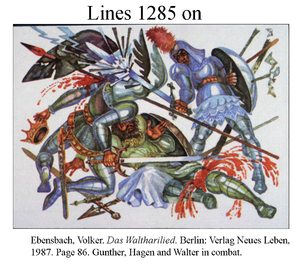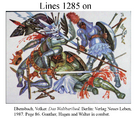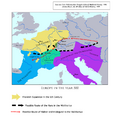Difference between revisions of "Waltharius1280"
| (One intermediate revision by the same user not shown) | |||
| Line 518: | Line 518: | ||
</gallery>}} | </gallery>}} | ||
|{{Meter|scansion=DDSSDS}} | |{{Meter|scansion=DDSSDS}} | ||
| − | | | + | |{{Comment| '''ursus''' Zwierlein suggests a parallel with Aen 10,707-18. In both cases an animal that is hunted by dogs serves as a comparison for a human hero. Vergil’s boar (aper) is turned into a numid bear (numidus ursus). (Zwierlein 2004 p538-9) Yet, there is little to none literal resemblance. Parallel to a Viennese dream codex of the 10th century (Vindob. Lat. 2723, fol. 130r) “Qui ursum se infestare vidit, inimici seditionem significat.” (If one has seen an attacking bear [in a dream], a battle with an enemy is signified.) Depending on the dating of the epic, the lunar might be either a source or reception. However, Zwierlein lists earlier examples of allegorical bible exegesis, where the bear figures as the devil’s ‘bestia rapacissima’, as savage military leader or as ‘potetstas saecularis’.” In Germanic dream tradition, enemies show as wolfs, while the hero figures as a bear. (Zwierlein 2004 pp542-3) Althof, in contrast, argues that the animal dream figures are driven by a Germanic dream tradition. Dreams in Vergil and other classic authors usually dream of human beings. Althof lists multiple examples of Germanic animal dreams (Althof 1905 vol2 pp190-1) Zwierlein lists counterexamples of animal allegories in classic sources, but is not able to create a direct link to the poem (Zwierlein 2004 p540) '''Numidus ... ursus''' 'ursos ... Numidas' appear in Juvenal 4.99-100. Geographic attributes such as African lions or Armenian tigers became popular for pure poetic purposes since the neoteric period. (Zwierlein 543, FN 119) Zwierlein claims that the Waltharius takes the ‘ursus numidus’ from a wide-spread medieval schoolbook Solin’s [[Collectanea rerum memorabilium]]. (Zwierlein 2004 p543) BK}} |
|- | |- | ||
|[[Et]] [[canibus1|canibus]] [[circumdatus]] [[astat]] [[et]] [[artubus]] [[horret]] | |[[Et]] [[canibus1|canibus]] [[circumdatus]] [[astat]] [[et]] [[artubus]] [[horret]] | ||
Latest revision as of 07:19, 12 December 2009
The fight begins and continues for seven hours; Gunther foolishly tries to retrieve a thrown spear from the ground near Walther and is only saved from death by Hagen’s brave intervention (1280–1345)
| Dixit et a tergo saltu se iecit equino, | 1280 | Translate: Hoc et Guntharius fecit, nec segnior hoc fecit heros
|
DSSSDS | |||
| Hoc et Guntharius nec segnior egerat heros | SDSDDS | |||||
| Waltharius, cuncti pedites bellare parati. | DSDSDS | |||||
| Stabat quisque ac venturo se providus ictu | Aeneid 3.458: venturaque bella. . . ‘The wars to come. . .’
|
SSSSDS Elision: quisque ac |
||||
| Praestruxit: trepidant sub peltis Martia membra. | Aeneid 7.182: martiaque. . .vulnera. . . ‘Wounds of war. . .’
|
SDSSDS | ||||
| Hora secunda fuit, qua tres hi congrediuntur, | 1285 | DDSSDS | ||||
| Adversus solum conspirant arma duorum. | SSSSDS | |||||
| Primus maligeram collectis viribus hastam | Maligeram: a very disputed hapax legomenon. Since the first a here is long, it should be equivalent to maliferam, (“apple-bearing,” an adjective found in Virgil) serving to figuratively describe the wood from which the hastam is made; the manuscript variant maligenam would make this easier. Perhaps more likely is that the poet, disregarding vowel-length, coined the word to mean “bearing evil.”
|
Aeneid 9.52-53: iaculum attorquens emittit in auras,/ principium pugnae. ‘Whirling a javelin, he sends it skyward to start the battle.’ Georgics 3.235: ubi collectum robur viresque refectae. . . ‘When his power is mustered and his strength renewed. . .’
|
SDSSDS | |||
| Direxit Hagano disrupta pace. sed illam | Aeneid 10.401: validam derexerat hastam. ‘He had launched his strong spear.’
|
SDSSDS | ||||
| Turbine terribilem tanto et stridore volantem | Aeineid 12.267: sonitum dat stridula cornus. ‘The whistling cornel shaft sings.’ 11.863-864.: teli stridorem aurasque sonantis/ audiit. ‘He heard the whistling dart and whirring air.’
|
DDSSDS Elision: tanto et |
||||
| Alpharides semet cernens tolerare nequire | 1290 | DSSDDS | ||||
| Sollers obliqui delusit tegmine scuti: | SSSSDS | |||||
| Nam veniens clipeo sic est ceu marmore levi | Eclogue 7.31: levi de marmore. . . ‘From polished marble. . .’ Aeneid 10.776-777.: stridentemque eminus hastam/ iecit. At illa volans clipeo est excussa proculque/ egregium Antoren latus inter et ilia figit. ‘He threw from far his whistling spear; as it flew, it glanced from the shield, and pierces noble Antores nearby between side and flank.’ 9.746: portaeque infigitur hasta. ‘The spear lodges in the gate.’
|
DDSSDS | ||||
| Excussa et collem vehementer sauciat usque | Eclogue 7.31: levi de marmore. . . ‘From polished marble. . .’ Aeneid 10.776-777.: stridentemque eminus hastam/ iecit. At illa volans clipeo est excussa proculque/ egregium Antoren latus inter et ilia figit. ‘He threw from far his whistling spear; as it flew, it glanced from the shield, and pierces noble Antores nearby between side and flank.’ 9.746: portaeque infigitur hasta. ‘The spear lodges in the gate.’
|
SSDSDS Elision: excussa et |
||||
| Ad clavos infixa solo. tunc pectore magno, | Ad clavos: up to the nails that attached the metal point to the wooden shaft.
|
Aeineid 2.544-545.: senior telumque imbelle sine ictu/ coniecit, rauco quod protinus aere repulsum/ et summo clipei nequiquam umbone pependit. ‘The old man hurled his weak and harmless spear, which straight recoiled from the clanging brass and hung idly from the top of the shield’s boss.’ Statius, Thebaid 9.533: pectore magno. . . ‘The mighty breast. . .’ Aeineid 4.448: magno. . .pectore.
|
SSDSDS | |||
| Sed modica vi fraxineum hastile superbus | 1295 | Aeineid 2.544-545.: senior telumque imbelle sine ictu/ coniecit, rauco quod protinus aere repulsum/ et summo clipei nequiquam umbone pependit. ‘The old man hurled his weak and harmless spear, which straight recoiled from the clanging brass and hung idly from the top of the shield’s boss.’ Statius, Thebaid 9.533: pectore magno. . . ‘The mighty breast. . .’ Aeineid 4.448: magno. . .pectore.
|
DSDSDS Hiatus: fraxineum hastile |
|||
| Iecit Guntharius, volitans quod adhaesit in ima | SDDDDS | |||||
| Waltharii parma, quam mox dum concutit ipse, | DSSSDS | |||||
| Excidit ignavum de ligni vulnere ferrum. | DSSSDS | |||||
| Omine quo maesti confuso pectore Franci | Aeineid 7.146-147.: omine magno/ crateras laeti statuunt. ‘Cheered by the mighty omen, they set on the bowls.’
|
|
DSSSDS | |||
| Mox stringunt acies, dolor est conversus ad iras, | 1300 | Aeineid 2.594: quis indomitas tantus dolor excitat iras? ‘What resentment thus stirs ungovernable wrath?’
|
SDDSDS | |||
| Et tecti clipeis Aquitanum invadere certant. | Aeneid 2.227: clipeique sub orbe teguntur. ‘They nestle under the circle of her shield.’
|
|
SDDSDS Elision: Aquitanum invadere |
|||
| Strennuus ille tamen vi cuspidis expulit illos | DDSDDS | |||||
| Atque incursantes vultu terrebat et armis. | Prudentius, Psychomachia 196: vultuque et voce minatur. ‘She menaces with look and speech.’
|
SSSSDS Elision: atque incursantes |
||||
| Hic rex Guntharius coeptum meditatur ineptum, | SDSDDS | |||||
| Scilicet ut iactam frustra terraeque relapsam, | 1305 | Iactam…relapsam: with hastam, line 1307.
|
DSSSDS | |||
| Ante pedes herois enim divulsa iacebat --, | DSDSDS | |||||
| Accedens tacite furtim sustolleret hastam, | Aeneid 9.546-547.: furtim/ sustulerat. ‘She had borne [him] secretly.’
|
SDSSDS | ||||
| Quandoquidem brevibus gladiorum denique telis | Brevibus gladiorum…telis: “the short reaches of their swords”
|
DDDSDS | ||||
| Armati nequeunt accedere comminus illi, | SDSDDS | |||||
| Qui tam porrectum torquebat cuspidis ictum. | 1310 | Cuspidis ictum equiv. to telum
|
Aeneid 7.756: cuspidis ictum. . . ‘The stroke of the spearpoint. . .’
|
SSSSDS | ||
| Innuit ergo oculis vassum praecedere suadens, | Vassum: “vassal,” i.e., Hagen. A word of Celtic derivation.
|
DDSSDS Elision: ergo oculis |
||||
| Cuius defensu causam supplere valeret. | Causam supplere valeret equiv. to [rex] rem perficere posset
|
SSSSDS | ||||
| Nec mora, progreditur Haganon ac provocat hostem, | DDDSDS | |||||
| Rex quoque gemmatum vaginae condidit ensem, | Prudentius, Psychomachia 105: condere vaginae gladium. ‘To sheathe the sword. . .’ Ovid, Metamorphoses 13.392: letalem condidit ensem. ‘He plunged his fatal sword.’
|
DSSSDS | ||||
| Expediens dextram furto actutum faciendo. | 1315 | Aeineid 12.258: expediuntque manus. ‘They spread out their hands.’
|
DSSSDS Elision: furto actutum |
|||
| Sed quid plura? manum pronus transmisit in hastam | SDSSDS | |||||
| Et iam comprensam sensim subtraxerat illam | Sensim subtraxerat: here the adverb clearly shows that the pluperfect has been substituted for the imperfect metri causa.
|
SSSSDS | ||||
| Fortunae maiora petens. sed maximus heros, | Fortunae equiv. to a fortuna
|
SSDSDS | ||||
| Utpote qui bello semper sat providus esset | DSSSDS | |||||
| Aeter et unius punctum cautissimus horae, | 1320 | Praeter…unius punctum…horae: “except for one moment of time,” a foreshadowing of lines 1381 ff.
|
DSSSDS | |||
| Hunc inclinari cernens persenserat actum | SSSSDS | |||||
| Nec tulit, obstantem sed mox Haganona revellens, | Revellens equiv. to pellens
|
Aeineid 8.256: non tulit Alcides. ‘Alcides did not tolerate this.’
|
DSSDDS | |||
| Denique sublato qui divertebat ab ictu, | Divertebat: Hagen “was stepping back from.”
|
DSSSDS | ||||
| Insilit et planta direptum hastile retentat | DSSSDS Elision: direptum hastile |
|||||
| Ac regem furto captum sic increpitavit, | 1325 | : Aeineid 10.810: Lausum increpitat. ‘He chides Lausus.’ 5.431-432.: tarda trementi/ genua labant. ‘His slow knees totter and tremble.’ 12.905: genua labant, gelidus concrevit frigore sanguis. ‘His knees buckle, his blood is frozen cold.’
|
SSSSDS | |||
| Ut iam perculso sub cuspide genva labarent. | Perculso sub cuspide equiv. to [regi] perculso quasi a cuspidis ictu. (Much debated. Cuspis is a femine noun, but cf. line 857.) Genva equiv. to genua (synizesis)
|
: Aeineid 10.810: Lausum increpitat. ‘He chides Lausus.’ 5.431-432.: tarda trementi/ genua labant. ‘His slow knees totter and tremble.’ 12.905: genua labant, gelidus concrevit frigore sanguis. ‘His knees buckle, his blood is frozen cold.’
|
SSSDDS | |||
| Quem quoque continuo esurienti porgeret Orco, | Porgeret equiv. to porrexisset
|
Aeineid 9.785: iuvenum primos tot miserit Orco? ‘Shall he send down to death so many of our noblest youths?’ 2.398: multos Danaum demittimus Orco. ‘Many a Greek we sent down to Orcus.’ Prudentius, Psychomachia 501-502.: et fors innocuo tinxisset sanguine ferrum,/ ni Ratio armipotens. . .clipeum obiectasset et atrae/ hostis ab incursu claros texisset alumpnos. ‘And perchance she would have dippedher steel in their innocent blood, had not the mighty warrior Reason put her shield in the way and covered her famed foster-children from their deadly foe’s onslaught.’
|
DDDSDS Elision: continuo esurienti |
|||
| Ni Hagano armipotens citius succurreret atque | Aeineid 9.785: iuvenum primos tot miserit Orco? ‘Shall he send down to death so many of our noblest youths?’ 2.398: multos Danaum demittimus Orco. ‘Many a Greek we sent down to Orcus.’ Prudentius, Psychomachia 501-502.: et fors innocuo tinxisset sanguine ferrum,/ ni Ratio armipotens. . .clipeum obiectasset et atrae/ hostis ab incursu claros texisset alumpnos. ‘And perchance she would have dippedher steel in their innocent blood, had not the mighty warrior Reason put her shield in the way and covered her famed foster-children from their deadly foe’s onslaught.’
|
DDDSDS Elision: Hagano armipotens Hiatus: ni Hagano |
||||
| Obiecto dominum scuto muniret et hosti | Aeineid 12.377: clipeo obiecto conversus in hostem/ ibat et auxilium ducto mucrone petebat. ‘He, with his shield before him, turned and was making for his foe, seeking aid from his drawn sword.’
|
SDSSDS | ||||
| Nudam aciem saevi mucronis in ora tulisset. | 1330 | DSSDDS Elision: nudam aciem |
||||
| Sic, dum Waltharius vulnus cavet, ille resurgit | Ille: Gunther
|
SDSDDS | ||||
| Atque tremens studiusque stetit, vix morte reversus. | Actus Apostolorum 9.6: tremens ac stupens dixit. . . ‘He, trembling and astonished, said. . .’ Statius, Silvae 5.1.172: media de morte reversa/ mens. . . ‘Her mind returning from the midst of death. . .
|
DDDSDS False quantities: STUPIDUSQUE? |
||||
| Nec mora nec requies: bellum instauratur amarum, | Aeneid 5.458; 12.553; Georgics 3.110: nec mora nec requies. ‘No rest, no stay is there.’ Aeineid 2.669-670.: sinite instaurata revisam/ proelia. ‘Let me seek again and renew the fights.’
|
DDSSDS Elision: bellum instauratur |
||||
| Incurrunt hominem nunc ambo nuncque vicissim; | SDSSDS | |||||
| Et dum progresso se impenderet acrius uni, | 1335 | Se impenderet: Waltharius
|
SSSDDS Elision: se impenderet |
|||
| En de parte alia subit alter et impedit ictum. | Aeineid 5.339: post Helymus subit. ‘Behind comes Helymus.’ 10.877: subit obvius. ‘He moves forward to meet him.’
|
SDDDDS Elision: parte alia |
||||
| Haud aliter, Numidus quam dum venabitur ursus | Venabitur: present passive sense
|
Aeineid 10.714: haud aliter. . . ‘Just so. . .’
|
|
DDSSDS | ursus Zwierlein suggests a parallel with Aen 10,707-18. In both cases an animal that is hunted by dogs serves as a comparison for a human hero. Vergil’s boar (aper) is turned into a numid bear (numidus ursus). (Zwierlein 2004 p538-9) Yet, there is little to none literal resemblance. Parallel to a Viennese dream codex of the 10th century (Vindob. Lat. 2723, fol. 130r) “Qui ursum se infestare vidit, inimici seditionem significat.” (If one has seen an attacking bear [in a dream], a battle with an enemy is signified.) Depending on the dating of the epic, the lunar might be either a source or reception. However, Zwierlein lists earlier examples of allegorical bible exegesis, where the bear figures as the devil’s ‘bestia rapacissima’, as savage military leader or as ‘potetstas saecularis’.” In Germanic dream tradition, enemies show as wolfs, while the hero figures as a bear. (Zwierlein 2004 pp542-3) Althof, in contrast, argues that the animal dream figures are driven by a Germanic dream tradition. Dreams in Vergil and other classic authors usually dream of human beings. Althof lists multiple examples of Germanic animal dreams (Althof 1905 vol2 pp190-1) Zwierlein lists counterexamples of animal allegories in classic sources, but is not able to create a direct link to the poem (Zwierlein 2004 p540) Numidus ... ursus 'ursos ... Numidas' appear in Juvenal 4.99-100. Geographic attributes such as African lions or Armenian tigers became popular for pure poetic purposes since the neoteric period. (Zwierlein 543, FN 119) Zwierlein claims that the Waltharius takes the ‘ursus numidus’ from a wide-spread medieval schoolbook Solin’s Collectanea rerum memorabilium. (Zwierlein 2004 p543) BK | |
| Et canibus circumdatus astat et artubus horret | Artubus: “paws”
|
Aeineid 10.714: haud aliter. . . ‘Just so. . .’
|
DSDDDS | |||
| Et caput occultans submurmurat ac propiantes | Caput occultans: “with head low” Propiantes equiv. to appropinquantes
|
DSSDDS | ||||
| Amplexans Umbros miserum mutire coartat, | 1340 | Amplexans: ironic sense Umbros: hunting hounds from Umbria in Italy Miserum: adverbial
|
|
SSDSDS | ||
| Tum rabidi circumlatrant hinc inde Molossi | Molossi: hunting hounds from Epirus
|
Aeineid 7.588: multis circum latrantibus undis. . . ‘Amid many howling waves. . .’
|
|
DSSSDS | ||
| Comminus ac dirae metuunt accedere belvae --, | Aeineid 10.712: nec cuiquam irasci propiusque accedere virtus. ‘No one is brave enough to rage or come near it.’
|
DSDSDS | ||||
| Taliter in nonam conflictus fluxerat horam, | DSSSDS | |||||
| Et triplex cunctis inerat maceratio: leti | Maceratio equiv. to tormentum, supplicium
|
SSDDDS | ||||
| Terror, et ipse labor bellandi, solis et ardor. | 1345 | DDSSDS |


